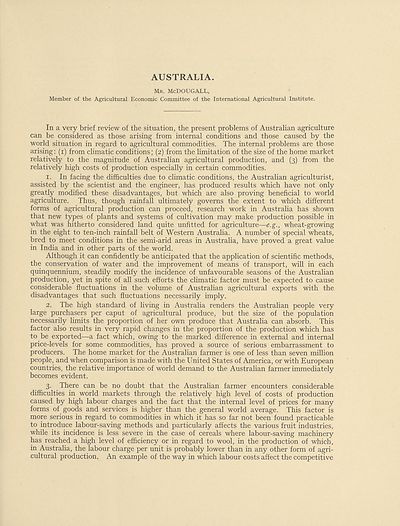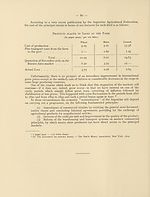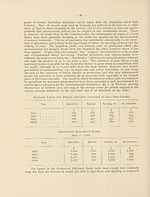Download files
Complete book:
Individual page:
Thumbnail gallery: Grid view | List view

AUSTRALIA.
Mr. McDOUGALL,
Member of the Agricultural Economic Committee of the International Agricultural Institute.
In a very brief review of the situation, the present problems of Australian agriculture
can be considered as those arising from internal conditions and those caused by the
world situation in regard to agricultural commodities. The internal problems are those
arising: (i) from climatic conditions; (2) from the limitation of the size of the home market
relatively to the magnitude of Australian agricultural production, and (3) from the
relatively high costs of production especially in certain commodities.
1. In facing the difficulties due to climatic conditions, the Australian agriculturist,
assisted by the scientist and the engineer, has produced results which have not only
greatly modified these disadvantages, but which are also proving beneficial to world
agriculture. Thus, though rainfall ultimately governs the extent to which different
forms of agricultural production can proceed, research work in Australia has shown
that new types of plants and systems of cultivation may make production possible in
what was hitherto considered land quite unfitted for agriculture—e.g., wheat-growing
in the eight to ten-inch rainfall belt of Western Australia. A number of special wheats,
bred to meet conditions in the semi-arid areas in Australia, have proved a great value
in India and in other parts of the world.
Although it can confidently be anticipated that the application of scientific methods,
the conservation of water and the improvement of means of transport, will in each
quinquennium, steadily modify the incidence of unfavourable seasons of the Australian
production, yet in spite of all such efforts the climatic factor must be expected to cause
considerable fluctuations in the volume of Australian agricultural exports with the
disadvantages that such fluctuations necessarily imply.
2. The high standard of living in Australia renders the Australian people very
large purchasers per caput of agricultural produce, but the size of the population
necessarily limits the proportion of her own produce that Australia can absorb. This
factor also results in very rapid changes in the proportion of the production which has
to be exported—a fact which, owing to the marked difference in external and internal
price-levels for some commodities, has proved a source of serious embarrassment to
producers. The home market for the Australian farmer is one of less than seven million
people, and when comparison is made with the United States of America, or with European
countries, the relative importance of world demand to the Australian farmer immediately
becomes evident.
3. There can be no doubt that the Australian farmer encounters considerable
difficulties in world markets through the relatively high level of costs of production
caused by high labour charges and the fact that the internal level of prices for many
forms of goods and services is higher than the general world average. This factor is
more serious in regard to commodities in which it has so far not been found practicable
to introduce labour-saving methods and particularly affects the various fruit industries,
while its incidence is less severe in the case of cereals where labour-saving machinery
has reached a high level of efficiency or in regard to wool, in the production of which,
in Australia, the labour charge per unit is probably lower than in any other form of agri¬
cultural production. An example of the way in which labour costs affect the competitive
Mr. McDOUGALL,
Member of the Agricultural Economic Committee of the International Agricultural Institute.
In a very brief review of the situation, the present problems of Australian agriculture
can be considered as those arising from internal conditions and those caused by the
world situation in regard to agricultural commodities. The internal problems are those
arising: (i) from climatic conditions; (2) from the limitation of the size of the home market
relatively to the magnitude of Australian agricultural production, and (3) from the
relatively high costs of production especially in certain commodities.
1. In facing the difficulties due to climatic conditions, the Australian agriculturist,
assisted by the scientist and the engineer, has produced results which have not only
greatly modified these disadvantages, but which are also proving beneficial to world
agriculture. Thus, though rainfall ultimately governs the extent to which different
forms of agricultural production can proceed, research work in Australia has shown
that new types of plants and systems of cultivation may make production possible in
what was hitherto considered land quite unfitted for agriculture—e.g., wheat-growing
in the eight to ten-inch rainfall belt of Western Australia. A number of special wheats,
bred to meet conditions in the semi-arid areas in Australia, have proved a great value
in India and in other parts of the world.
Although it can confidently be anticipated that the application of scientific methods,
the conservation of water and the improvement of means of transport, will in each
quinquennium, steadily modify the incidence of unfavourable seasons of the Australian
production, yet in spite of all such efforts the climatic factor must be expected to cause
considerable fluctuations in the volume of Australian agricultural exports with the
disadvantages that such fluctuations necessarily imply.
2. The high standard of living in Australia renders the Australian people very
large purchasers per caput of agricultural produce, but the size of the population
necessarily limits the proportion of her own produce that Australia can absorb. This
factor also results in very rapid changes in the proportion of the production which has
to be exported—a fact which, owing to the marked difference in external and internal
price-levels for some commodities, has proved a source of serious embarrassment to
producers. The home market for the Australian farmer is one of less than seven million
people, and when comparison is made with the United States of America, or with European
countries, the relative importance of world demand to the Australian farmer immediately
becomes evident.
3. There can be no doubt that the Australian farmer encounters considerable
difficulties in world markets through the relatively high level of costs of production
caused by high labour charges and the fact that the internal level of prices for many
forms of goods and services is higher than the general world average. This factor is
more serious in regard to commodities in which it has so far not been found practicable
to introduce labour-saving methods and particularly affects the various fruit industries,
while its incidence is less severe in the case of cereals where labour-saving machinery
has reached a high level of efficiency or in regard to wool, in the production of which,
in Australia, the labour charge per unit is probably lower than in any other form of agri¬
cultural production. An example of the way in which labour costs affect the competitive
Set display mode to:
![]() Universal Viewer |
Universal Viewer | ![]() Mirador |
Large image | Transcription
Mirador |
Large image | Transcription
Images and transcriptions on this page, including medium image downloads, may be used under the Creative Commons Attribution 4.0 International Licence unless otherwise stated. ![]()
| League of Nations > Economic and financial section > Agricultural crisis > Volume 1 > (89) |
|---|
| Permanent URL | https://digital.nls.uk/190903807 |
|---|
| Shelfmark | LN.II.2/2.(35) |
|---|---|
| Attribution and copyright: |
|
| Shelfmark | LN.II.2/2.(35-35) |
|---|---|
| Shelfmark | LN.II |
|---|
| Description | Over 1,200 documents from the non-political organs of the League of Nations that dealt with health, disarmament, economic and financial matters for the duration of the League (1919-1945). Also online are statistical bulletins, essential facts, and an overview of the League by the first Secretary General, Sir Eric Drummond. These items are part of the Official Publications collection at the National Library of Scotland. |
|---|---|
| Additional NLS resources: |
|

